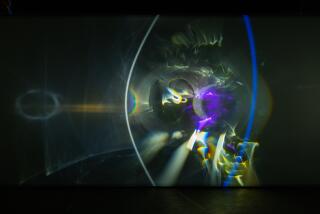A sculptural ramble with Richard Serra
- Share via
There’s always more than meets the eye in Richard Serra’s monumental steel sculpture -- as visitors will see Feb. 16, when the Los Angeles County Museum of Art opens the Broad Contemporary Art Museum, bankrolled by financier and collector Eli Broad.
Two of Serra’s 2006 works, which debuted at his recent 40-year retrospective at the Museum of Modern Art in New York, command the entire ground floor of the new building, designed by architect Renzo Piano. Wrap-around environments that are impossible to see in their entirety from a single vantage point, they are expected to remain in place for about a year.
“Band,” a 183-ton ribbon of weatherproof steel that stands almost 13 feet tall and undulates through a “footprint” of about 70 by 37 feet, occupies the east gallery. A new addition to LACMA’s collection, it was purchased for an undisclosed sum from a $10-million acquisitions fund established by Broad. (His own enormous personal collection will remain under the control of his Foundation, he let it be known last week.) “Sequence,” a sculpture of roughly the same size and composed of two twisted elliptical structures encircled by a serpentine passageway, is in the west gallery. Lent by Serra, it’s destined for a museum that Gap founder Donald Fisher plans to build for his collection in San Francisco.
Several years in the making, the sculptures are wonders of design and engineering. Although Serra, 68, has been exhibiting “Torqued Ellipses,” massive steel enclosures with curved and slanted walls, for a decade, it isn’t easy to imagine how he dreamed up these two works in his New York studio or how they were made in Germany and transported here.
The installation alone -- finessed while the building was under construction -- was a highly synchronized, 10-day effort by a trusted crew that works 12-hour days. Each work consists of enormous panels that must be aligned within a 32nd of an inch.
Precision, planning and overcoming obstacles, such as doorways and uneven floors -- Serra and his team have all that down to a science. But it’s not what excites him.
“It’s just part of what I do,” Serra says, walking around “Band” just after its installation. “I’m interested when the pieces are set up. I would just as soon that the process evaporates and you have to deal with the experience of the work.”
For museum visitors, that’s inevitable. These are sculptures that reach out and envelop all who enter, but they don’t reveal all their secrets. Elusiveness is as essential to the art as an imposing physical presence.
“What you have with ‘Band’ is a very logical floor plan,” Serra says of his most recent work, which introduces a wavy, ribbon-like template. “But in elevation, everything leans continuously in opposing directions, which means that as the band unfolds, nothing ever repeats itself and no volume is ever the same. So even though you walk in and out of four cavities and you have a sense that they are very similar, they are all different.
“You might find yourself in a space where you think you have been before, but you realize it is different and you don’t know quite why. And then you find yourself in another space, and you think it’s the outside of the space you have just been in, but it’s not. Or you think it’s the inside of the space that you just left, but it’s not. If you continuously walk the piece, what you anticipate and what your memory allows you to foresee don’t always conclude to be what you suspect.”
Like the earlier “Torqued Ellipses,” “Band” and “Sequence” differ from much current art, he says, because “you and your experience is the content of the work. In work that is representational or in a frame, the subject matter is a depiction or literal manifestation of a person, place or event. Here, the subject matter is your experience, and it’s yours and yours alone. It differs for everyone even though there’s a common threshold. What you have is people having a private experience in a public space with other people. It’s a kind of collective experience that’s both private and public.”
A native of San Francisco who settled in New York in the mid-1960s, Serra has had a low profile in Southern California for decades. But in the last couple of years, major works have been installed at UCLA, the Orange County Performing Artscenter and the Museum of Contemporary Art San Diego. Once identified with a brutal form of Minimalism that occasionally incited protest, Serra still looks the part of the macho blue-collar artist, but his public image has changed. Although “Torqued Ellipses” and their successors are anything but warm and fuzzy, they have been embraced by the masses as well as many critics.
“That’s something I could not have anticipated, and it started happening about 10 years ago, when I showed the ‘Torqued Ellipses’ at Dia in New York,” he says. “I think people yearn for direct experience, something that is not programmed. Here, you are free to come and go where you want. There is no beginning or end. There is not a hierarchy of experiences built into it.”
--
More to Read
The biggest entertainment stories
Get our big stories about Hollywood, film, television, music, arts, culture and more right in your inbox as soon as they publish.
You may occasionally receive promotional content from the Los Angeles Times.










